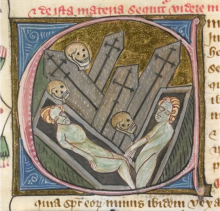The days are getting shorter and nights longer, and, once again, we are decorating our windows and doors with spooky ghosts and scary creatures. With Halloween around the corner, Prof. Charity Urbanski’s new book, Medieval Monstrosity: Imagining the Monstrous in Medieval Europe, couldn’t be more on topic. To understand the origins of contemporary monsters that thrive in our imaginations and pop culture today, Urbanski takes us on a journey to medieval Europe. Her book not only has the strength to draw undergraduate students into the historical study of medieval Europe but also contains a message for modernist historians.
Urbanski’s interest in monsters goes back to her childhood and is characterized by a fascination with the strength and magical abilities of these creatures. But she also feels a deep sympathy for monsters as social outcasts. A sympathy, which her undergraduate students share, who love fantasy literature for its strong yet ostracized characters. Meeting her students and a broader non-academic audience through this shared passion, Urbanski’s new book highlights how medieval texts about monsters can be analyzed as valuable historical sources. Using such texts, depictions of monsters can be studied as cultural products, which express the anxieties not only of Christian medieval Europe but also of our own society today.
In her classroom, Urbanski teaches undergraduate students to identify change and continuity over time. Changes in the portrayal of monsters, for instance, express shifts in societal anxieties. To provide a contemporary example, the depiction of revenants changed a lot over the course of the 20th century. While zombies in the U.S. popular culture of the 1950s were often portrayed as victims of voodoo and expressed white Americans’ racist fear of others viewed as “exotic,” we witness a shift in the 1970s towards conceptualizing the undead as products of disease and infection.
Just as depictions of modern-day monsters have evolved rapidly alongside society, medieval monsters underwent similarly fascinating and scary transformations, as well. Depictions of dragons, for example, started to be gendered in the 13th and 14th century. Leading up to this time, in the 11th and 12th century, fierce debates took place within the church around the question of whether clerics should be allowed to marry, which resulted in a strict celibacy mandate during the late medieval period. This change was paralleled by a general push to exclude women from religious life. Urbanski explains that dragons symbolized sin and functioned as an outlet to transfer one’s own desire for sinful behavior unto a non-human creature. Thus, we begin to see images of dragons – symbols of repressed desire – with female genitalia.
One of Urbanski’s main goals in studying history is to explain how we arrived where we are today by showing that elements of our contemporary cultural products have roots in the medieval period. Her book and her teaching, however, contain a further important message: we need to differentiate between fictional monsters and monstrous portrayals of humans. The structure of Urbanski’s new work raises awareness for this important differentiation by providing a clear division of chapters. The first section contains a chapter discussing the representation of non-Europeans as monstrous races, while chapters two and three are devoted to the depiction of non-Christians – Jews and Muslims – and female bodies as monstrous. Urbanski hopes that reading this part of the book will help students to better identify modern anti-Muslim and anti-Jewish sentiments in public discourse by tracing their origins to medieval Europe. The final part of the book explores medieval imaginings of monsters that are still popular today: revenants, werewolves, and dragons. Narrowing down these three creatures and excluding other beloved fantastical beings was a difficult part of writing this book.
Urbanski’s book also contains an important lesson for modernist historians. Her research and teaching not only explore the origins of our contemporary institutions such as the state and the church in the medieval period but also show continuity in regard to European’s racial thinking. Recently, medievalists have been debating whether pre-modern Europeans were already dividing the world in terms of races. While emphasizing the importance of differentiating between medieval concepts of race (gens in Latin) and modern racism, Urbanski shows that medieval ideas on monstrosity contain the seeds for the racialization of difference in subsequent centuries. Thus, Urbanski encourages colleagues who focus on studying race in the modern period to trace the concept further back and to step into the unknown terrain of the medieval world. And what would be more fun than learning about medieval Europe through monsters?
